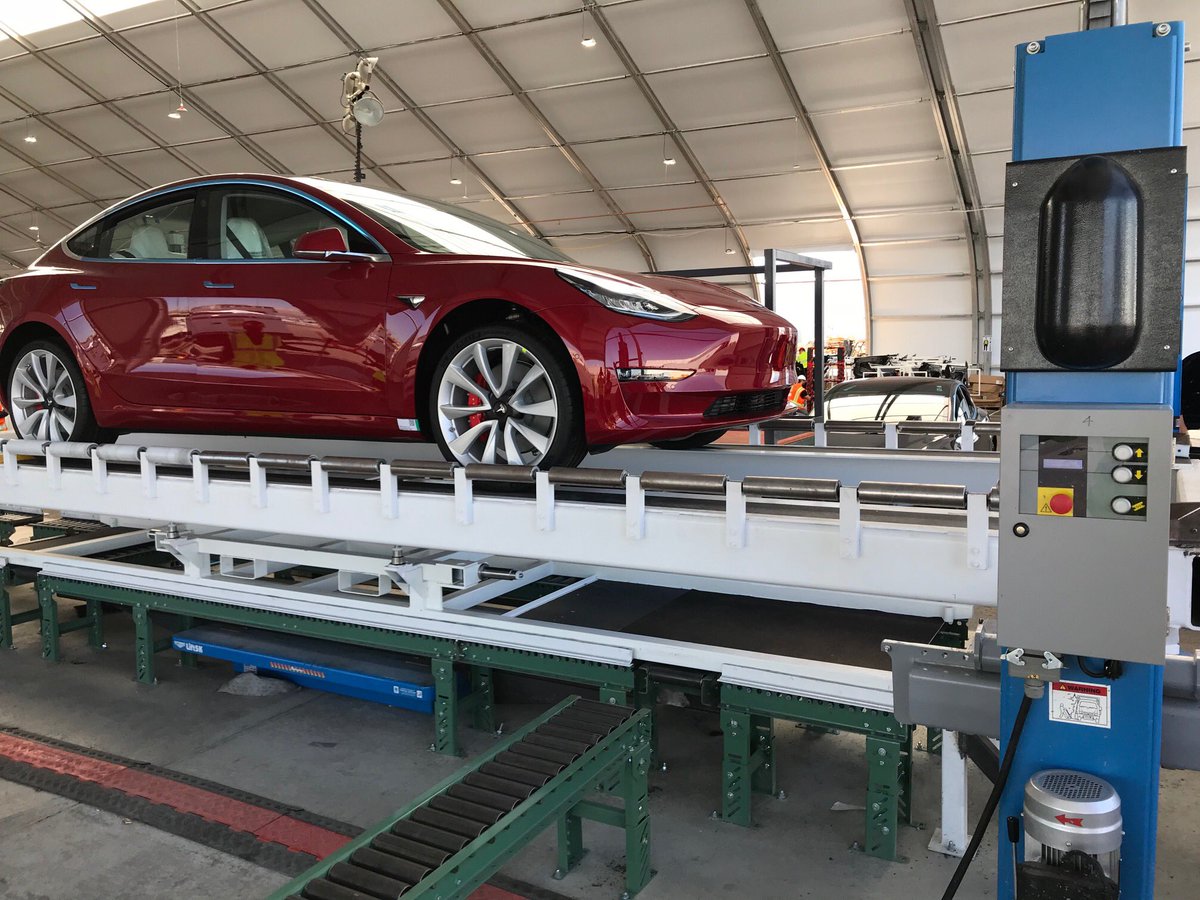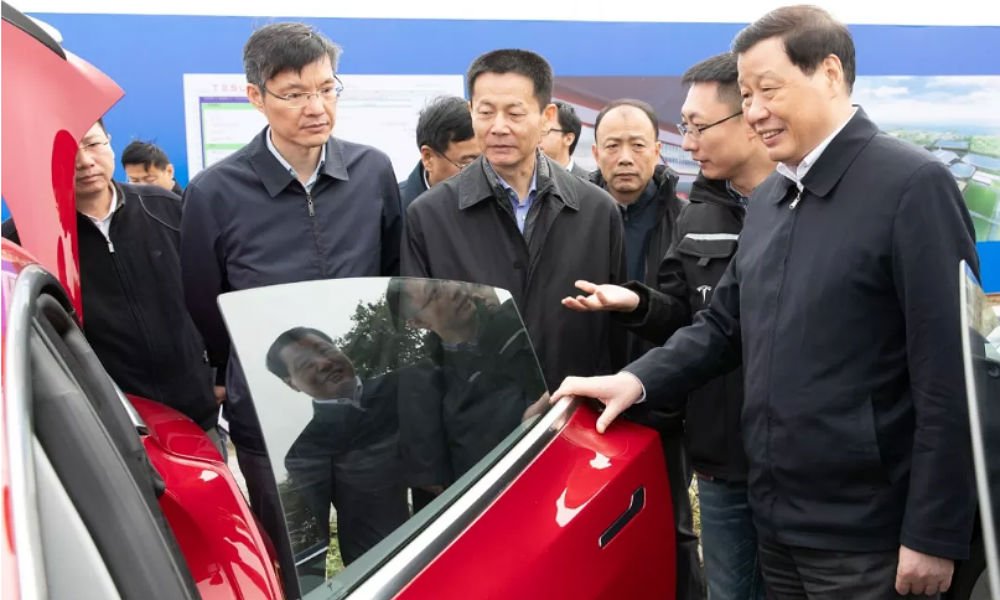

Investor's Corner
Tesla Model 3 production in Gigafactory 3 to begin in second half of 2019: report
The development of Tesla’s Gigafactory 3 continues to move at a rapid pace, with recent reports suggesting that electric car production in the upcoming facility could begin as early as the second half of 2019. Provided that there are no delays in the construction of the factory itself, and provided that Tesla can ship and set up its production lines on time, the latter half of 2019 could signal the beginning of Model 3 production in China.
Local media outlet Caijing.com noted that the factory is about to begin construction, particularly since the 864,885-square meter plot of land in the Lingang Industrial Zone has been leveled. In a post on its official WeChat account, the Shanghai government further indicated that Mayor Ying Yong and Vice Mayor Wu Qing have met with Tesla’s leaders in China while checking the company’s new vehicles like the Model 3. During their visit, the Shanghai officials reportedly encouraged parties involved in the project to expedite the construction of Gigafactory 3 even more.

The progress of Tesla’s Gigafactory 3 has been nothing short of remarkable. When Elon Musk announced the target timeline for the project earlier this year, the company’s critics were immediately skeptical. Tesla initially noted that vehicle production in Gigafactory 3 would start roughly two years after the facility’s construction begins, ramping to an output of 500,000 vehicles per year 2-3 years after. The timeline, which could only be described as classic Elon Musk, was met with doubts from Wall Street. Consumer Edge Research senior auto analyst James Albertine, for one, dubbed Gigafactory 3’s timeline as “not feasible.”
Despite its initial timeline already being met by raised eyebrows from Wall Street, Tesla announced an even more aggressive target for the project after its stellar third quarter. In its Q3 vehicle production and deliveries report, Tesla noted that it was accelerating the construction of Gigafactory 3. The company also noted that it expects the facility’s construction to be rapid and capital-efficient, thanks to lessons learned from the Model 3 ramp in the United States.
Beyond the lessons from the Model 3 ramp, credit is due to the Chinese government for its support for Tesla and the upcoming factory. Local state media has been openly supportive of the project and Tesla as a whole, and the government even bent its rules a little by allowing the electric car maker to become the sole owner of Gigafactory 3. The government’s support became particularly evident when Tesla went unchallenged in its bid for an 864,885-square meter plot of land in Shanghai’s Lingang area, as well as in the rapid release of low-interest loans for the project from local Shanghai banks.
November 29th 2018, Tesla Direct Experience Center officially grand opening at the Wenzhou Fortune Experience Center. To date, Tesla has more than 44 direct experience centers and service centers in mainland China 🇨🇳 .$TSLA #Tesla #China #TeslaChina pic.twitter.com/X8nJHVJCNz
— vincent (@vincent13031925) November 30, 2018
The Chinese government’s favor for Tesla has allowed the company to maintain a strong brand in the country, despite challenges posed by a 40% import tariff placed on the Model S and Model X due to the trade war between China and the United States. Even before US President Donald Trump announced on Twitter that the Chinese government has agreed to “reduce and remove” import tariffs on vehicles from the United States, Tesla’s electric cars, particularly the Model 3, have been garnering a lot of interest among Chinese consumers. This interest became evident during a recent job fair at the Lingang Industrial Zone, when Tesla was forced to extend its hiring hours due to the overwhelming number of applicants for job openings at Gigafactory 3.
Considering China’s reputation for building large-scale facilities in record time, an initial Model 3 production run in Gigafactory 3 by the second half of 2019 is actually quite feasible. With the country’s capability to construct the facility quickly, the start of Model 3 production in China next year would likely be limited only by Tesla’s capability to ship and set up its vehicle production lines on time. If Tesla can accomplish this, there is very little that can go in the way of Gigafactory 3 producing the Model 3 for the local Chinese market before 2019 ends.
Tesla has the potential to be a force in China’s auto market, particularly as the country is aggressively pushing the electrification of its transport sector. China is on track to sell 2 million electric vehicles by 2020 and attain an ICE to EV ratio of 1:1 by 2030. Tesla’s Gigafactory 3, which is expected to produce 500,000 cars per year, could go a long way in helping the country achieve its own ambitious electric car goals, particularly as the company is expected to produce its two mass-market vehicles in the facility — the Model 3 sedan and the Model Y SUV.
Elon Musk
Tesla analyst issues stern warning to investors: forget Trump-Musk feud

A Tesla analyst today said that investors should not lose sight of what is truly important in the grand scheme of being a shareholder, and that any near-term drama between CEO Elon Musk and U.S. President Donald Trump should not outshine the progress made by the company.
Gene Munster of Deepwater Management said that Tesla’s progress in autonomy is a much larger influence and a significantly bigger part of the company’s story than any disagreement between political policies.
Munster appeared on CNBC‘s “Closing Bell” yesterday to reiterate this point:
“One thing that is critical for Tesla investors to remember is that what’s going on with the business, with autonomy, the progress that they’re making, albeit early, is much bigger than any feud that is going to happen week-to-week between the President and Elon. So, I understand the reaction, but ultimately, I think that cooler heads will prevail. If they don’t, autonomy is still coming, one way or the other.”
BREAKING: GENE MUNSTER SAYS — $TSLA AUTONOMY IS “MUCH BIGGER” THAN ANY FEUD 👀
He says robotaxis are coming regardless ! pic.twitter.com/ytpPcwUTFy
— TheSonOfWalkley (@TheSonOfWalkley) July 2, 2025
This is a point that other analysts like Dan Ives of Wedbush and Cathie Wood of ARK Invest also made yesterday.
On two occasions over the past month, Musk and President Trump have gotten involved in a very public disagreement over the “Big Beautiful Bill,” which officially passed through the Senate yesterday and is making its way to the House of Representatives.
Musk is upset with the spending in the bill, while President Trump continues to reiterate that the Tesla CEO is only frustrated with the removal of an “EV mandate,” which does not exist federally, nor is it something Musk has expressed any frustration with.
In fact, Musk has pushed back against keeping federal subsidies for EVs, as long as gas and oil subsidies are also removed.
Nevertheless, Ives and Wood both said yesterday that they believe the political hardship between Musk and President Trump will pass because both realize the world is a better place with them on the same team.
Munster’s perspective is that, even though Musk’s feud with President Trump could apply near-term pressure to the stock, the company’s progress in autonomy is an indication that, in the long term, Tesla is set up to succeed.
Tesla launched its Robotaxi platform in Austin on June 22 and is expanding access to more members of the public. Austin residents are now reporting that they have been invited to join the program.
Elon Musk
Tesla surges following better-than-expected delivery report
Tesla saw some positive momentum during trading hours as it reported its deliveries for Q2.

Tesla (NASDAQ: TSLA) surged over four percent on Wednesday morning after the company reported better-than-expected deliveries. It was nearly right on consensus estimations, as Wall Street predicted the company would deliver 385,000 cars in Q2.
Tesla reported that it delivered 384,122 vehicles in Q2. Many, including those inside the Tesla community, were anticipating deliveries in the 340,000 to 360,000 range, while Wall Street seemed to get it just right.
Tesla delivers 384,000 vehicles in Q2 2025, deploys 9.6 GWh in energy storage
Despite Tesla meeting consensus estimations, there were real concerns about what the company would report for Q2.
There were reportedly brief pauses in production at Gigafactory Texas during the quarter and the ramp of the new Model Y configuration across the globe were expected to provide headwinds for the EV maker during the quarter.
At noon on the East Coast, Tesla shares were up about 4.5 percent.
It is expected that Tesla will likely equal the number of deliveries it completed in both of the past two years.
It has hovered at the 1.8 million mark since 2023, and it seems it is right on pace to match that once again. Early last year, Tesla said that annual growth would be “notably lower” than expected due to its development of a new vehicle platform, which will enable more affordable models to be offered to the public.
These cars are expected to be unveiled at some point this year, as Tesla said they were “on track” to be produced in the first half of the year. Tesla has yet to unveil these vehicle designs to the public.
Dan Ives of Wedbush said in a note to investors this morning that the company’s rebound in China in June reflects good things to come, especially given the Model Y and its ramp across the world.
He also said that Musk’s commitment to the company and return from politics played a major role in the company’s performance in Q2:
“If Musk continues to lead and remain in the driver’s seat, we believe Tesla is on a path to an accelerated growth path over the coming years with deliveries expected to ramp in the back-half of 2025 following the Model Y refresh cycle.”
Ives maintained his $500 price target and the ‘Outperform’ rating he held on the stock:
“Tesla’s future is in many ways the brightest it’s ever been in our view given autonomous, FSD, robotics, and many other technology innovations now on the horizon with 90% of the valuation being driven by autonomous and robotics over the coming years but Musk needs to focus on driving Tesla and not putting his political views first. We maintain our OUTPERFORM and $500 PT.”
Moving forward, investors will look to see some gradual growth over the next few quarters. At worst, Tesla should look to match 2023 and 2024 full-year delivery figures, which could be beaten if the automaker can offer those affordable models by the end of the year.
Investor's Corner
Tesla delivers 384,000 vehicles in Q2 2025, deploys 9.6 GWh in energy storage
The quarter’s 9.6 GWh energy storage deployment marks one of Tesla’s highest to date.

Tesla (NASDAQ: TSLA) has released its Q2 2025 vehicle delivery and production report. As per the report, the company delivered over 384,000 vehicles in the second quarter of 2025, while deploying 9.6 GWh in energy storage. Vehicle production also reached 410,244 units for the quarter.
Model 3/Y dominates output, ahead of earnings call
Of the 410,244 vehicles produced during the quarter, 396,835 were Model 3 and Model Y units, while 13,409 were attributed to Tesla’s other models, which includes the Cybertruck and Model S/X variants. Deliveries followed a similar pattern, with 373,728 Model 3/Ys delivered and 10,394 from other models, totaling 384,122.
The quarter’s 9.6 GWh energy storage deployment marks one of Tesla’s highest to date, signaling continued strength in the Megapack and Powerwall segments.

Year-on-year deliveries edge down, but energy shows resilience
Tesla will share its full Q2 2025 earnings results after the market closes on Wednesday, July 23, 2025, with a live earnings call scheduled for 4:30 p.m. CT / 5:30 p.m. ET. The company will publish its quarterly update at ir.tesla.com, followed by a Q&A webcast featuring company leadership. Executives such as CEO Elon Musk are expected to be in attendance.
Tesla investors are expected to inquire about several of the company’s ongoing projects in the upcoming Q2 2025 earnings call. Expected topics include the new Model Y ramp across the United States, China, and Germany, as well as the ramp of FSD in territories outside the US and China. Questions about the company’s Robotaxi business, as well as the long-referenced but yet to be announced affordable models are also expected.
-

 Elon Musk3 days ago
Elon Musk3 days agoTesla investors will be shocked by Jim Cramer’s latest assessment
-

 News1 week ago
News1 week agoTesla Robotaxi’s biggest challenge seems to be this one thing
-

 News2 weeks ago
News2 weeks agoTexas lawmakers urge Tesla to delay Austin robotaxi launch to September
-

 Elon Musk2 weeks ago
Elon Musk2 weeks agoFirst Look at Tesla’s Robotaxi App: features, design, and more
-

 Elon Musk2 weeks ago
Elon Musk2 weeks agoxAI’s Grok 3 partners with Oracle Cloud for corporate AI innovation
-

 News2 weeks ago
News2 weeks agoSpaceX and Elon Musk share insights on Starship Ship 36’s RUD
-

 News2 weeks ago
News2 weeks agoWatch Tesla’s first driverless public Robotaxi rides in Texas
-

 News2 weeks ago
News2 weeks agoTesla has started rolling out initial round of Robotaxi invites














